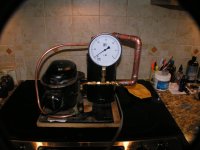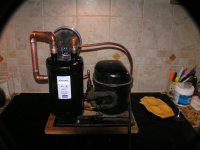I want to do some vacuum distillations to reduce the boiling temperature of some solvents. I had an old working refrigerator compressor laying around in my shop. To regulate the amount of vacuum applied to the distillation apparatus, I have provided a needle valve and a large vacuum gauge. I have invested about $50 into the project for a large gauge, an accumulator to prevent fluid from being sucked into the compressor, along with some copper fittings and pipe.
I have not tried this beast yet for distillations, but it does pull a damn hard vacuum at about 29.5 inches Hg. I have used it to evacuate an auto A/C unit that I repaired, and it worked beautifully.
I will report on its use in a distillation in the near future. Here are a couple of photos if anyone is curious about building one similar to it.
I have not tried this beast yet for distillations, but it does pull a damn hard vacuum at about 29.5 inches Hg. I have used it to evacuate an auto A/C unit that I repaired, and it worked beautifully.
I will report on its use in a distillation in the near future. Here are a couple of photos if anyone is curious about building one similar to it.


